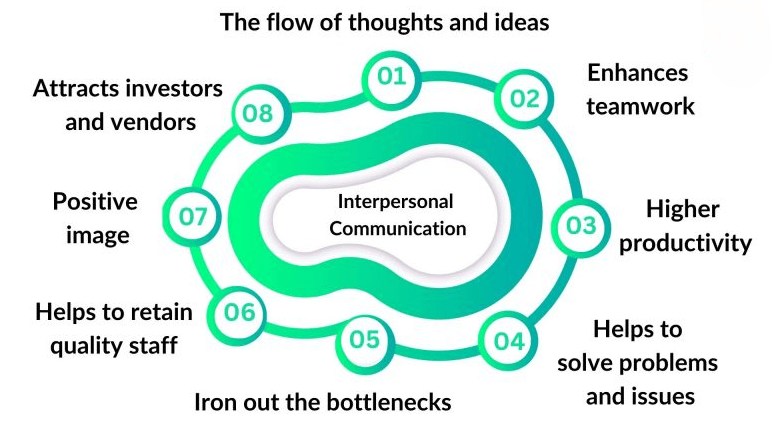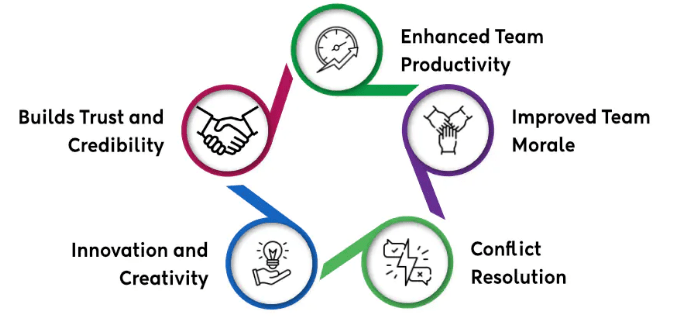
- Introduction to Interpersonal Communication
- What is Interpersonal Communication?
- The Importance of Interpersonal Communication
- Effective Communication Techniques
- Barriers to Effective Interpersonal Communication
- Improving Your Interpersonal Communication Skills
- The Role of Empathy in Communication
- Conclusion
Introduction to Interpersonal Communication
Effective communication is essential to building strong relationships, whether personal or professional. How we communicate directly impacts trust, collaboration, and understanding. Interpersonal communication is the exchange of information, emotions, and ideas between individuals. It encompasses both verbal communication (the words we use) and nonverbal communication (such as body language, facial expressions, and tone of voice). This form of communication is shaped by several factors, including context, cultural influences, and emotional intelligence. For instance, the way we communicate may differ depending on whether we’re speaking in a formal setting or having a casual conversation during Data Science Training. Additionally, cultural norms and emotional awareness can significantly affect how messages are received and interpreted. Mastering interpersonal communication skills is crucial for enhancing your ability to listen actively, resolve conflicts, and express yourself clearly. It also helps build rapport, foster collaboration, and create meaningful connections. Whether in the workplace, with family, or in social situations, strong communication skills allow you to navigate complex interactions and form lasting, productive relationships. Improving this skill can lead to greater personal and professional success.
Go Through These Data Science Interview Questions & Answer to Excel in Your Upcoming Interview.
What is Interpersonal Communication?
Interpersonal communication is the process of exchanging information, emotions, and meaning between two or more people. It is both a skill and an art that requires the use of both verbal and non-verbal methods. Verbal communication involves spoken or written words, while non-verbal communication includes body language, gestures, tone of voice, and facial expressions. These elements work together to convey messages clearly and ensure that communication is effective, much like understanding What is Data Analysis. The primary goal of interpersonal communication is to share ideas, feelings, and information while maintaining a positive and productive relationship between the communicators. This process involves several stages, including encoding the message (putting thoughts into words or actions), decoding (interpreting the message), and responding appropriately. The ability to understand non-verbal signals, such as body language or tone, plays a significant role in interpreting the true meaning behind words.

Ultimately, interpersonal communication is about building connection, trust, and mutual understanding. It helps people relate to each other, resolve conflicts, and collaborate effectively. Mastering this skill is crucial in both personal relationships and professional environments, where clear communication can lead to greater success and harmony.
The Importance of Interpersonal Communication
- Builds and Maintains Relationships: Effective interpersonal communication is essential for forming and maintaining both personal and professional relationships.
- Enhances Collaboration: In team environments, clear and open communication improves cooperation, coordination, and shared decision-making, making group work more efficient and effective.
- Facilitates Conflict Resolution: Strong communication skills help individuals address disagreements constructively, express concerns calmly, and reach mutual understanding without escalating tensions.
- Improves Emotional Intelligence: Communicating with empathy and awareness enhances emotional intelligence by allowing individuals to recognize and manage their own emotions and understand others better, which is essential in the Future Scope of Machine Learning.
- Strengthens Professional Success: Good communicators are often more successful in the workplace. They are better at networking, managing teams, leading projects, and advancing in their careers.
- Encourages Active Listening: Interpersonal communication emphasizes listening attentively, which leads to better comprehension, fewer misunderstandings, and stronger interpersonal bonds.
- Supports Mental and Emotional Well-Being: Being able to express thoughts and feelings clearly contributes to emotional release, reduced stress, and a greater sense of belonging and support.
- Promotes Cultural and Social Understanding: It helps bridge cultural and social differences by encouraging openness, respect, and sensitivity to diverse perspectives, leading to more inclusive interactions.
- Active Listening: Active listening involves fully concentrating on the speaker, avoiding interruptions, and providing feedback that shows understanding. This encourages open dialogue and builds trust.
- Clear and Concise Messaging: Communicate your thoughts clearly and avoid unnecessary jargon. Being concise ensures your message is easy to understand and reduces the chance of misinterpretation, just like understanding Dispersion in Statistics.
- Nonverbal Communication: Body language, facial expressions, gestures, and eye contact play a critical role in communication. Aligning your nonverbal cues with your words reinforces your message and builds credibility.
- Empathy and Emotional Awareness: Understanding and acknowledging others’ emotions promotes respectful, compassionate interactions. Empathetic communication strengthens relationships and helps in conflict resolution.
- Open-Ended Questions: Asking questions that encourage detailed responses fosters deeper conversations and shows genuine interest in the other person’s thoughts and feelings.
- Constructive Feedback: Providing feedback in a positive, respectful way helps others grow without feeling criticized. Use “I” statements and focus on behavior rather than personal traits.
- Adaptability: Tailoring your communication style to suit the audience or context enhances effectiveness. Being flexible shows emotional intelligence and increases the chances of your message being well-received.
- Manage Stress and Emotions: Learning to stay calm under pressure helps maintain clear communication, especially in conflicts or emotionally charged conversations.
- Adapt Your Communication Style: Every situation and person is different. Adjust your tone, pace, and message according to your audience to improve connection and understanding.
- Practice Active Listening: Focus entirely on the speaker, avoid interrupting, and show that you’re engaged through nodding, maintaining eye contact, and providing thoughtful responses.
- Enhance Your Emotional Intelligence: Understanding and managing your emotions, as well as recognizing others’ feelings, allows you to communicate more empathetically and respond more appropriately in different situations, much like applying Simple Linear Regression in data analysis.
- Be Aware of Nonverbal Cues: Pay attention to your body language, facial expressions, and tone of voice. These cues often speak louder than words and can either support or contradict your message.
- Develop Clarity and Confidence: Speak clearly and with confidence to convey your thoughts effectively. Avoid filler words, stay on topic, and use simple language to ensure your message is understood.
- Give and Receive Feedback: Be open to constructive feedback and use it to improve. Also, practice giving feedback in a respectful, helpful manner that encourages growth rather than defensiveness.
Want to Learn About Data Science? Explore Our Data Science Interview Questions & Answer Featuring the Most Frequently Asked Questions in Job Interviews.
Effective Communication Techniques

Barriers to Effective Interpersonal Communication
Several barriers can hinder effective communication, making it difficult to convey or understand messages accurately. Being aware of these barriers is the first step toward overcoming them and improving interpersonal interactions. Language barriers are among the most common obstacles. Differences in language, vocabulary, or the use of jargon can lead to confusion and misinterpretation. Even when speaking the same language, unfamiliar terms or complex expressions can disrupt clear communication. Cultural differences can also create challenges. People from different cultural backgrounds may have varying communication styles, values, and expectations during Data Science Training. Gestures, tone, and even eye contact can carry different meanings across cultures, leading to misunderstandings if not properly understood or respected. Emotional barriers occur when strong feelings such as anger, stress, or frustration cloud judgment or distort how messages are sent and received. Emotional tension can cause individuals to misinterpret intent or respond defensively. Physical barriers, such as noisy environments, poor audio quality, or physical distance, can also interfere with communication. These environmental factors can distract or prevent participants from focusing on the conversation, resulting in missed or misheard information. By recognizing and addressing these barriers, individuals can foster more effective and meaningful communication.
Want to Pursue a Data Science Master’s Degree? Enroll For Data Science Masters Course Today!
Improving Your Interpersonal Communication Skills
The Role of Empathy in Communication
Empathy plays a vital role in effective interpersonal communication. It is the ability to understand and share another person’s feelings, allowing you to connect with others on a deeper emotional level. In both personal and professional settings, empathy fosters trust, respect, and mutual understanding, which are crucial for building meaningful relationships. Understanding empathy means being aware of others’ emotions and perspectives without immediately judging or trying to fix the situation. It requires stepping into someone else’s shoes and genuinely trying to feel what they are experiencing. Empathy enhances communication by creating a safe and supportive environment, much like understanding Ridge and Lasso Regression Explained Using Python. When you show empathy, you acknowledge and validate the other person’s emotions, which helps them feel heard and respected. This, in turn, encourages more honest and open conversations, reducing the likelihood of conflict or misunderstanding. Practicing empathy in daily conversations involves active listening, paying full attention to the speaker, observing non-verbal cues, and responding thoughtfully. Instead of offering quick solutions, try reflecting on what the person is feeling and respond with understanding and care. Over time, cultivating empathy can significantly improve the quality of your interactions and strengthen your personal and professional relationships.
Want to Learn About Data Science? Explore Our Data Science Interview Questions & Answer Featuring the Most Frequently Asked Questions in Job Interviews.
Conclusion
Mastering interpersonal communication goes beyond merely exchanging words it involves truly understanding others and ensuring that your message is clearly received. Effective communication requires a combination of awareness, active listening, and emotional intelligence. Being attentive to both verbal and non-verbal cues, such as body language, facial expressions, and tone of voice, helps you interpret the full meaning behind what someone is saying. Active listening plays a central role in effective communication. This means giving your full attention, avoiding interruptions, and responding thoughtfully during Data Science Training. Asking clarifying questions not only demonstrates engagement but also ensures mutual understanding. Offering constructive feedback and remaining open to receiving it are also vital in maintaining respectful and productive conversations. Incorporating key concepts like empathy, feedback, and open-mindedness into your communication style helps build trust, resolve misunderstandings, and foster stronger relationships. These skills are equally important in both personal and professional contexts. Ultimately, honing interpersonal communication skills creates a more collaborative and supportive environment, improves teamwork, enhances conflict resolution, and promotes meaningful, lasting connections. It’s an ongoing process, but one that significantly enriches how we relate to and understand one another.


